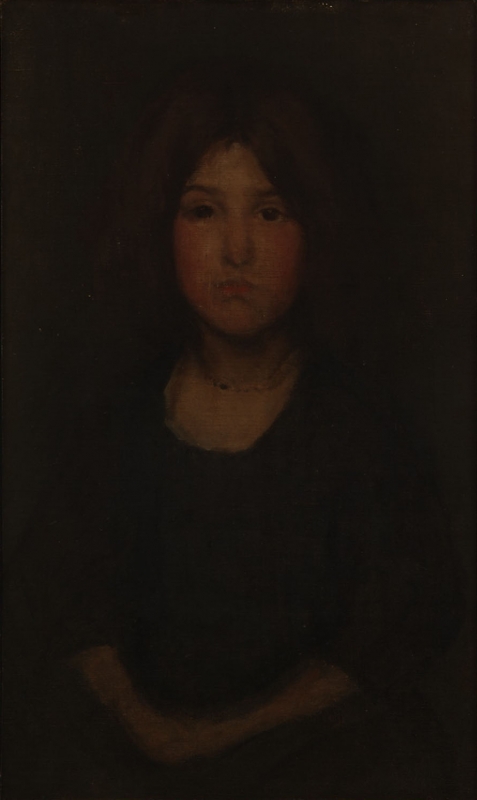Home > Catalogue > Browse > The Little Faustina << >>
Titles
Two titles have been suggested:
- 'Comment tu t'appelle' (1903, C. L. Freer). 1
- 'The Little Faustina' (1903 and 1909, R. B. Philip). 2
- 'The Little Faustina' (1905, Œuvres de James McNeill Whistler, Paris). 3
- 'The Little Faustina' (1980, YMSM). 4
The 1905 title, 'The Little Faustina', is generally accepted.
Description
A half-length portrait of a girl in vertical format. She is facing the viewer, with her hands clasped in her lap. She has brown eyes, a fresh pink complexion, and dark brown hair with a central parting. She wears a plain black dress with a round neck and poses in front of a dark background.
Sitter
She was Italian, according to Arthur Jerome Eddy (1859-1920), who wrote, 'Some years ago [Whistler] showed a visitor several heads of Italian children, each about ten or twelve, by sixteen or eighteen inches in size. With them was a three-quarter length of one of the children'. 5
Charles Lang Freer (1856-1919) recorded seeing Vert et or: Le Raconteur [YMSM 513] in Whistler's studio in 1903, and identified the model as the 'Brother of the boy with a cloak' (The Boy in a Cloak [YMSM 512]) and of The Little Faustina [YMSM 510]). His record of the portraits presumably reflects information given by the artist, and is as follows:
"Le Raconteur" / The boy with mischievous face - hand and thumb / Brother of the boy with cloak
"Comment tu t'appelle"/ The marvellous little girl full face - eyes looking into futurity - her two little hands folded and at rest in her lap -/ Sister of the boy in cloak and of the Raconteur
Asked to be held for C L F
Mr George Vanderbilt to have the little boy with fine eyes . brother ... of the Raconteur - And the same boy painted in the "Boy in the cloak".' 6
Freer bought the 'Raconteur' in 1905 and The Little Faustina [YMSM 510] in 1909, but George Washington Vanderbilt (1862-1914) did not buy one of these family portraits.
Curry thought that the title might be 'a somewhat melodramatic reference to the child's future potential as a temptress', since Faustina, wife of the Roman Emperor Marcus Aurelius, 'was supposedly licentious.' 7 Whistler could well have known the poem 'Faustine' by Algernon Charles Swinburne (1837-1909), that was inspired by images and stories about the empress, and was published in The Spectator on 31 May 1862. It gave a fairly extreme image of a decadent and dangerous woman ('You have the face that suits a woman / For her soul's screen — / The sort of beauty that's called human / In hell, Faustine.')
It is also possible that Whistler made the connection to his earlier enthusiasm for the burlesque Little Dr Faust at the Gaiety Theatre, where he had made many sketches in the late 1870s (see Harmony in Blue: The Duet [YMSM 196]).
However, Faustina was also the name of a saint and a popular name for girls, since it derives from the Latin 'faustus' meaning fortunate.
Notes:
1: [1903], Diaries, Bk 13, Freer Gallery Archives.
2: [1903], label on verso, and note, 12 July 1909, GUL Whistler BP II Ledger a, p. 89.
3: Œuvres de James McNeill Whistler, Palais de l'Ecole des Beaux-Arts, Paris, 1905 (cat. no. 43).
4: YMSM 1980 [more] (cat. no. 510).
5: Eddy 1903 [more], pp. 273-74.
6: [1903], Diaries, Bk 13, Freer Gallery Archives.
Last updated: 25th November 2020 by Margaret






